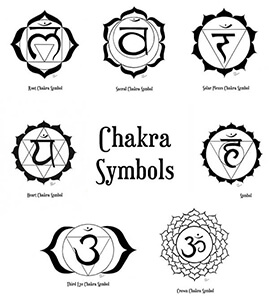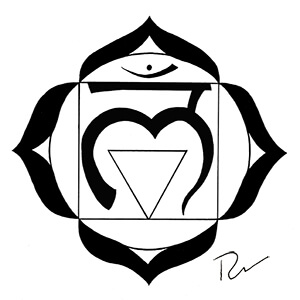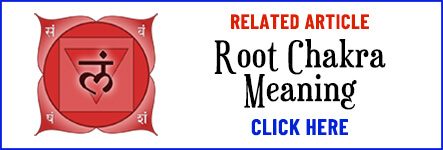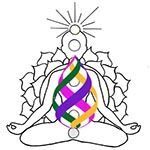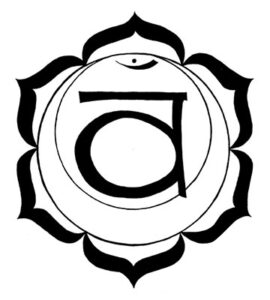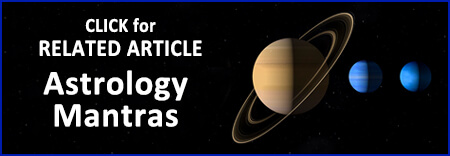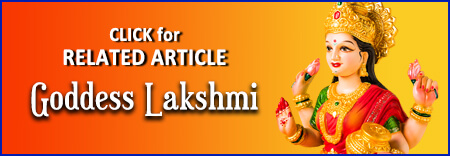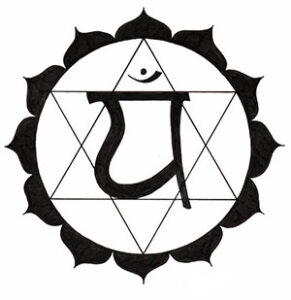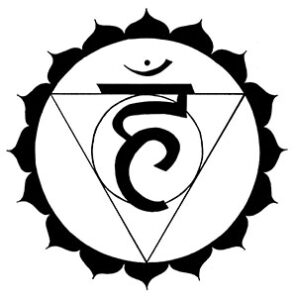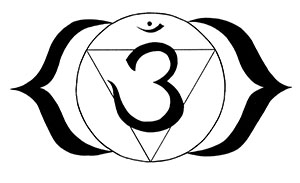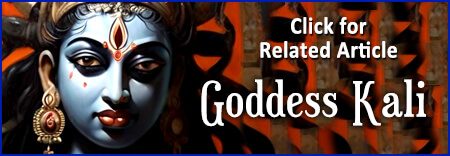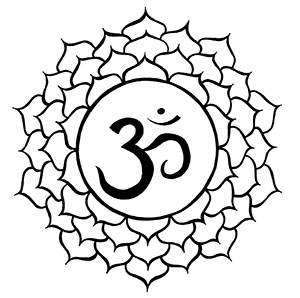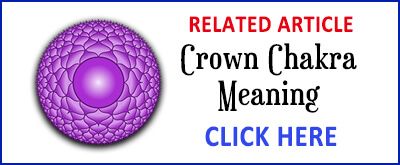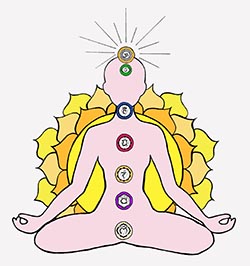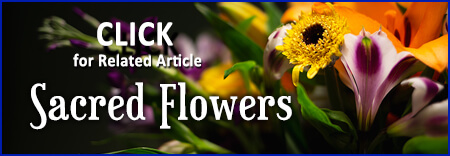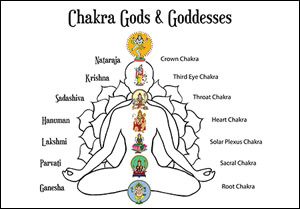
Chakra Symbols
A Complete Guide to Your Life Energy
There are beautiful chakra symbols representing the seven major energy centers in the body. Chakra symbols are composed of geometric forms as well as organic forms such as petals and flowers. The Sanskrit chakra symbols are similar to mandalas or yantras. Most significantly, the symbols associated with each chakra are keys to understanding the flow of spiritual energy in the body.
Table of Contents
Share this page with a friend!
Where Do Chakra Symbols Come From?
Chakra symbols come from ancient Eastern traditions. According to these texts and teachings, chakras are spiritual centers that allow or impede the flow of energy in the human body. They are also associated with emotional and psychological patterns.
Uses of the 7 Chakra Symbols
Chakra symbols can be used for meditation and visualization. The seven chakra signs serve as depictions of the the unseen forces that govern the energy and strength of the seven major chakras. Chakra symbols are a visual reminder of the power that enlivens the human body and spirit.
Chakra Symbols as Energy Patterns
Chakra symbols are an artistic depiction of energy patterns which are unseen but may have a very real impact on life, health and spirituality. The descriptions below are a detailed analysis of each chakra symbol beginning with the root chakra and moving upwards to the crown chakra.
FREE download: Set of the 7 chakra symbols.
Using Chakra Symbols for Healing
For thousands of years, the science of the chakra signs has been taught by Eastern yogis. This knowledge has now made its way into the lexicon and consciousness of the West. Chakra symbols are an extremely useful tool for visualizing these energy centers and working with the central themes for each. These ancient Vedic symbols encode the psychological and emotional connections for the chakras. This gives you insight into healing and balancing your chakras.
Clearing the Chakras
All life experiences are stored in one or more chakra. Clearing the chakras of negativity is a process that can be accomplished in many ways. Tools for this purpose include meditation, affirmations, mantras, yoga, dietary practices, and self-examination.
Karma and Emotional Patterns
In addition to their role in directing spiritual energy into the physical body, the chakras are also associated with emotional and psychological patterns. Some say that karma is stored in the chakras: the result of both good deeds and harmful actions.
Chakras as Wheels Spinning
The chakras are often described as wheels. If a chakra has records of negative patterns, the energy may not flow freely. A balanced, cleared chakra would be like a wheel that spins easily.
Related Article: Root Chakra Meaning
Root Chakra Symbols Meaning
The root chakra establishes the foundation for the seven major chakras. The base or root chakra is our fundamental connection to the physical plane. The root chakra is related to security and safety. This is also the place where ancestral memories reside.
Watch nearly 300 videos on our YouTube channel!
Root Chakra and Physical Organs
The root chakra governs the lower part of the body, including the feet, legs, knees, hips, lower back and lower spine. These areas of the body establish balance and stability. The chakra symbol for the root reflects this functionality.
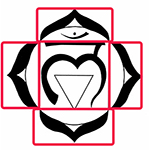
Lotus Petals in Root Chakra Symbols
In the Hindu tradition, the base chakra is depicted as a lotus flower with four petals. Each of the petals represent one of the mental states associated with this chakra. The interpretations and translations of the meaning associated with each of these petals vary widely.
Meaning of Root Chakra Petals
The four petals of root chakra symbols are generally viewed as mind, intellect, consciousness and ego. Alternately, the petals can represent four forms of longing:
- dharma (psychological longing)
- artha (soul longing)
- kama (physical longing)
- moksha (longing for spiritual liberation)
Sanskrit Meanings
Some of the variations in the meanings associated with each of the four petals may be due to the difficulty of translating directly from Sanskrit, a language that assigns many meanings to a single word. The judgments needed to determine the exact meaning of a word in a particular context can be difficult to make.
Polysemy in Sanskrit Terms
Of course this is common in other languages as well (thus the term homonyms). However, having multiple meanings for a single word is so prolific in Sanskrit that the term polysemy is more appropriate. Polysemy means that many related terms can be associated with a single word. Polysemy leads to sets and subsets of related meanings.
Four Aspects of Consciousness
In addition to the four forms of longing noted above, the four petals depicted in root chakra symbols are also symbolic of four specific aspects of higher consciousness:
- great joy
- natural pleasure
- delight in controlling passion
- blissfulness in concentration
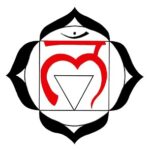
Sanskrit Characters in Root Chakra Symbols
The Sanskrit character in the center of root chakra symbols represents the syllable LAM. This is the bija or seed syllable for this chakra. This sound (pronounced LUHM) can activate and balance the root chakra. At a deeper level, every letter in the Sanskrit alphabet carries a specific vibration.
Bija Seed Syllable LAM
For example, in the sound LAM, the initial “L” is a semi-vowel. This means that the “L” sound can be extended to a certain degree, though possibly not as long as a an open vowel (A, E, I, O, U). The longer the sound can be held, the more physical the effect. The absence of sound or silence remains in the spiritual realm.
Power of Semi-Vowels
Semi-vowels are connected to the four elements of nature (earth, water, fire and air) because they are halfway between the physical realm and the spiritual realm. From this perspective, LAM is the sound connected to the earth element. The sound “L” is also associated with joy, creativity and femininity. This sound is connected to happiness and Lakshmi, the goddess of wealth.
Primal Sounds
The short “A” in the middle (pronounced UH) is the most primal of all sounds. This is the fundamental or root vibration of the vocal chords, the most basic opening necessary to produce sound. Thus, this sound is an affirmation of life and the exhalation of breath.
Sound of the Divine Mother
The final “M” represents dissolution and transformation. The sound “M” is generally associated with the Divine Mother in Her many forms. “M” initiates the word for Mother in many languages: Mother, Mama, Mom, Mor, Ma, Madre, Mater, Mueter, etc.

Square Base in Root Chakra Symbols
Most interpretations of the Hindu chakra symbols for the root chakra interpret the central square as a metaphor for stability. This chakra provides the foundation upon which the other chakras rest. The root chakra can also be seen as connected with your personal and ancestral history.
Safety in the World
These are the roots that can either bind you to the earth in a negative sense or give you a strong base and presence in the world in the positive sense. A balanced and strong root chakra affords the ability to stand your ground and feel safe in the world.
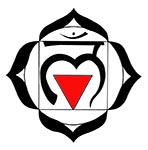
Upside Down Triangle in Chakra Symbols
The upside-down triangle is an alchemical symbol for water and feminine energy. The triangle in the center of root chakra symbols is balancing the earth energy of the larger square in which it resides. The triangle is the primary form that can enclose space within straight lines. The triangle is viewed as the first form to emerge from chaos.
Kundalini Energy
The fundamental polarity of the root chakra is feminine. The kundalini energy that is coiled in the root is seen as the energy of the Divine Mother or the universal Goddess. This energy is drawn to the masculine energy of spirit in the higher chakras and the crown chakra.
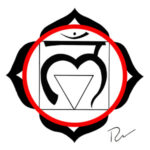
Circles in Root Chakra Symbols
The circle is the most fundamental of all forms, symbolizing infinite space and expansiveness. The circle is present in all physical matter from the atom to planetary bodies. The circle symbolizes the central quest of spirituality: to realize oneness with all of creation.
Circle Symbolic Meaning
Children begin to draw full circles around the age of three. Even earlier than that, they draw a circle with legs attached to represent people: mother, father, teacher and others. A circle represents totality and wholeness. The circle is a metaphor for the family, social unit, or sphere in which a child dwells.
Related Chakra Articles
Circle and the Spiritual Path
Likewise, the circle represents the sphere in which we all dwell as adults. The spiritual path is generally thought to begin with clearing and balancing the root chakra. The circle is therefore an appropriate aspect of root chakra symbols as well as all seven of the chakra symbols.
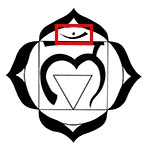
Crescent Moon in Chakra Symbols
In the upper area root chakra symbols is a white crescent moon. This represents water energy and the emotions. The unconscious, connected to all the three of the lower chakras, is sometimes symbolized as the ocean.
Moon as the Secondary Light
In Hinduism, the moon is seen as a source of light protecting individuals in the darkness of the night. All forms of light are welcomed, including the secondary light of the moon. The moon is associated with the god known as Chandra.
Symbolism of the Moon
The light of the sun is steady and bright. The light of the moon is unstable, waxing and waning through the month. Thus the moon symbolizes the cycles of life while the sun symbolizes the fundamental energy of life.
Meaning of the Dot
The dot above the crescent moon is similar to the Bindu, the dot often applied to the center of the forehead between the eyebrows in the East. The dot symbolizes the third eye. This is the place of spiritual vision or insight. The crescent moon and dot appear in all seven chakra symbols.
Related Article: Sacral Chakra Meaning
Sacral Chakra Symbols Meaning
The sacral chakra is the seat of the self as an individual and in relationship with others. The sacral chakra is the focus of reproduction, creativity and physical love. The sacral chakra is the center of exchange including communication and finances.
Seat of the Soul Chakra
The sacral chakra is sometimes called the seat of the soul. The organs associated with the sacral chakra include the reproductive organs, lower back, large intestines, hips, kidneys and bladder. In Hinduism, the sacral chakra is associated with Lakshmi, the goddess of wealth.
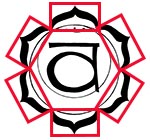
Meaning of the Six Lotus Petals
The six petals of the sacral chakra are associated with the Sanskrit syllables BAM, BHAM, MAM, YAM, RAM and LAM. The chakra syllables can be chanted or used in mantras for the sacral chakra. These syllables can be interpreted as the overcoming of undesirable modes of consciousness.
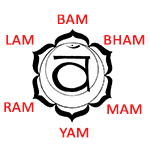
Translating the Six Petal Meaning
The six syllables represent the following: affection, pitilessness, all-destructivity, delusion, disdain, and suspicion. In this usage, the word “affection” has the negative connotation of bellowing (as a cow or bull) or begging or vying for attention. The aspects of the six syllables may alternately be translated as:
- wrath (bam)
- hate (bham)
- jealousy (mam)
- cruelty (YAM)
- lust (RAM)
- pride (LAM)
Deities of the Chakra Petals
Once purified, the syllables become powerful sounds invoking the deities or forms of God that have overcome the negativity and now embody the opposite qualities.
Sacral Chakra Sanskrit Character Meaning
The Sanskrit character in the center stands for VAM, the seed syllable for this chakra. This is also called a bija syllable. This is a basic sound that can strengthen and clear this chakra. VAM is pronounced “VUHM.”
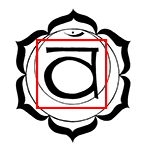
Decoding the Sanskrit Sounds
Like the “L” for seed syllable LAM associated with the root chakra, the “V” is a semi-vowel. This means that this sound is connected to one of the main physical elements, in this case the water element. “V” encompasses adaptability and receptivity.
Mantra for the Sacral Chakra
The short “A” (UH) is a basic sound affirming life and breath. The closing “M” is a feminine sound associated with the Divine Mother. VAM can be used as a one word mantra or as a word in a longer mantra such as “OM VAM Namaha” (I give honor to the energy of the sacral chakra).

Meaning of the Sacral Chakra Circles
The circles symbolize the cycles of life, death, nature and the universe. As the most basic of all forms, the circle encloses physical matter. The two circles in the sacral chakra symbols are offset to form a moon shape. This is also symbolic of cycles and the light present in all seasons and times of day.
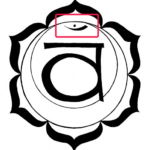
Sacral Chakra Crescent Moon
In the upper area of the sacral chakra symbol is a white crescent moon representing water energy and the emotions. The unconscious, said to be connected to the sacral chakra, is sometimes symbolized as the ocean.
Chandra, God of the Moon
The crescent moon is the source of reflected light connected to Chandra, the god of the moon in Hinduism. The dot above the crescent is like the Bindu, a dot placed between the eyebrows symbolizing the third eye or prophetic vision and intuition.
Solar Plexus Chakra Symbols Meaning
The solar plexus chakra is the seat of intuition and emotional power. This is the place of gut feelings. The solar plexus chakra is connected to the action of digestion: breaking down substances, thoughts and ideas into useful forms.
Place of the Sun
Symbolically speaking, the solar plexus is the place of the sun. This can be seen in the solar plexus chakra symbol with ten petals surrounding an inner circle. Mastery of the solar plexus is equivalent to mastery of the emotions, a tremendous power.
Related Article: Solar Plexus Chakra Meaning
Solar Plexus as the Third Brain
A number of ancient and indigenous cultures see the solar plexus center as the “third brain.” This is a place that combines intellectual knowledge (first brain) with the feelings of the heart (second brain). The combination of thought and feeling creates the wisdom of the solar plexus.
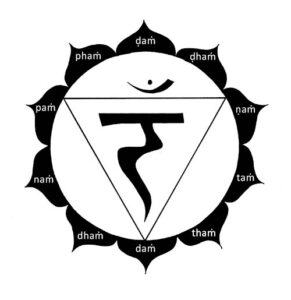
Meaning of the Ten Lotus Petals
The solar plexus chakra is represented as a ten-petaled lotus. The lotus petals symbolize the unfolding of spirituality or divinity. The ten petals represent the life force that connects our minds, body and soul in specific ways. The lotus symbol is also connected to the energy of creation.
Characteristics of the Ten Petals
Each petal corresponds to a Sanskrit bija or seed syllable. Spiritual practices may involve the sounding of each seed syllable to stimulate that particular energy. Some petals and sounds are repeated in a downward and an upward form. These petals represent the spiritual overcoming of ten corresponding negative characteristics:
- ignorance (dam)
- thirst (dham)
- jealousy (nam)
- treachery (tam)
- shame (tham)
- fear (dam)
- disgust (dham)
- delusion (nam)
- foolishness (pam)
- sadness (pham)
Meaning of the Solar Plexus Triangle
The downward triangle represents water, a feminine element. An upward triangle would be masculine, the fire element. Water is often associated with the emotional nature of both men and women. Clearly there is a connection to physical tears.
Water and the Divine Feminine
All forms of water have a feminine quality: the ocean, rivers, creeks, rain and snow. Many cultures personify forms of water as feminine nature spirits or goddesses. For example, the river Ganges in India is the home of Mata Ganga (Mother Ganges).
Sanskrit Character RAM
The center symbol is the Sanskrit character for the seed syllable RAM, the central sound for the solar plexus chakra. More in the article Chakra Sounds.
Solar Plexus Crescent Moon
The symbol of the single stroke with the dot above at the top of the solar plexus chakra symbol represents the moon and the emotions, another source of feminine energy.
Solar Plexus Chakra and Mantras
Other mantras for the chakras focus on deities associated with each chakra. These deities may be understood on emotional and psychological as well as religious levels. For the solar plexus, these deities include Rudra, Lakini and Lakshmi.
Related Article: Heart Chakra Meaning
Heart Chakra Symbols Meaning
The heart is the fourth chakra counting from the root chakra or base of the spine. The Sanskrit name of the heart chakra is the Anahata chakra. In Sanskrit, “Anahata” means “unhurt, unstruck, unbeaten.” At the same time, Anahata means “pure” or “clean.”
Heart Chakra and Physical Organs
The physical organs associated with the heart chakra are the heart itself, the circulatory system and the lungs. As the seat of love and devotion, the heart expresses charity, compassion, and kindness. The heart is at the center of many spiritual traditions including Hinduism, Buddhism, Christianity and others.
Wisdom of the Heart Chakra
The heart is also a focus for beauty and culture. The heart is also a center of wisdom and functions like a second brain. The heart is centrally located as the hub of the energetic system of the body as well as the powerhouse that keeps blood and oxygen pumping throughout the body.
Meaning of the Triangles
The downward triangle represents water, a feminine element. Water is often associated with the emotional nature of both men and women. An upward triangle would be masculine, associated with the fire element. The two triangles of the heart chakra represent the balance of the masculine and feminine energies in the heart.
Meaning of the Heart Chakra Circles
The circles symbolize the cycles of life, death, nature and the universe. As the most basic of all forms, the circle encloses physical matter and represents the universe as a whole. The circle encompasses both the masculine and feminine energies of the heart chakra triangles.
Sanskrit Character YAM
The symbol within the interlocking triangles is the Sanskrit character for the sound YAM, the seed syllable of the heart chakra. This is the sound that activates the heart chakra. More about the sounds, seed syllables and mantras associated with the chakras at Chakra Sounds.
Lotus Petals in the Heart Chakra Symbol
The lotus is connected to the energy of creation and symbolizes the unfolding of spirituality or divinity. The lotus symbolizes purity, enlightenment and transcendence.
Meaning of the Lotus Flower
Lotus petals are part of every chakra representation. Depending on the chakra, there may be anything from two to fifty petals or the proverbial “thousand-petalled lotus” of the crown chakra. The lotus illustrates the unfolding of the divine essence within.
Twelve Petals of the Heart Chakra
The twelve petals of the heart chakra symbol correspond to the twelve months of the year and the twelve astrological signs. The twelve positive qualities of the heart chakra include peace, bliss, love, harmony, empathy, understanding, unity, forgiveness, compassion, kindness, purity, and clarity.
Crescent Moon in the Heart Chakra Symbol
The symbol of the single stroke with the dot above at the top of the heart chakra symbol represents the moon and the emotions, a source of feminine energy. The moon also represents water energy. Finally, the moon symbolizes the unconscious mind and the hidden aspects of nature. The moon is often associated with goddesses.
Related Article: Throat Chakra Meaning
Throat Chakra Symbols Meaning
The throat chakra features a lotus flower with sixteen petals. The fifth chakra is known as the Vishuddha chakra. In Sanskrit, Vishuddha means “especially pure.” The glyph and dot at the top of the throat chakra symbolizes the moon, a form of feminine energy. The surrounding circle symbolizes manifestation as a whole.
Creativity and Self-Expression
The throat chakra is connected with creativity and self-expression as well as the actions of speaking and chanting. This chakra is associated with the neck, the esophagus, the teeth, the mouth and the ears.
Gateway to the Digestive System
As the gateway to the digestive system, the throat chakra is said to have the ability to neutralize the poisons of life. This protects us from “swallowing” impure food or unpleasant feelings. On the other hand, the throat is also connected to addictions centered around food, alcohol and drugs.
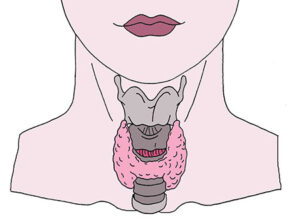
Healing the Throat Chakra
Healing stones believed to positively influence the throat chakra are lapis lazuli, turquoise, and aquamarine. Many of these stones a re blue, which some consider to be the color of a purified throat chakra. Learn more in the article Chakra Stones and Crystal Meanings.
Imbalances in the Throat Chakra
Imbalances in the throat chakra can appear as throat issues, neck stiffness, trouble breathing, and thyroid problems. A positive affirmation for the throat chakra is “I express myself and my truth.”
The seed syllable for the throat chakra is HAM (hum). The Vedic mantra for this chakra is “Om Ham Namaha.” This sound honors and strengthens the energy of positive personal power and finding your own voice.
Watch nearly 300 videos on our YouTube channel!
Third Eye Chakra Symbols Meaning
The third eye chakra is the door to prophetic vision, psychic intuition and seeing the future. This sacred spot is sometimes marked in the East on the forehead by the red dot known as the bindi.
Lotus Petals and Third Eye Chakra Meaning
The third eye is symbolized as a transparent lotus flower with two white petals representing the ida and pingala (mystical spiritual channels) or Shiva and Shakti on the left and right, respectively. The ida and pingala are sometimes considered to be the unconscious and conscious minds or the pineal and pituitary glands.
Pineal Gland and the Third Eye
The pineal gland has been revered as a central endocrine gland for spiritual development. The pituitary is a master gland that monitors and regulates many bodily functions including growth, sexual maturity, metabolism and blood pressure.
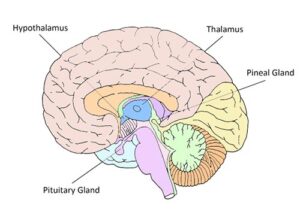
The name pineal comes from the Latin pinea or pinus, meaning pine cone. Representations of the pineal gland are used symbolically in art of the Sumerians, Egyptians, Indonesians, Greeks, Romans and Babylonians. Some traditions say that the soul enters and leaves the physical body at birth and death through the pineal gland.
Sanskrit Characters and Third Eye Chakra Symbols
The Sanskrit symbol in the center is the character for OM, the seed syllable for the third eye chakra. In addition, each of the two petals have their own syllables. These seed syllables are HAM (for Shiva on the left) and KSHAM (for Shakti on the right). The petals are also the home for the deity Hakini. She is the embodiment of pure-mindedness. Learn more in the article Chakra Sounds.
Related Article: Third Eye Chakra Meaning
The Triangle in the Third Eye Symbol
The downward triangle inside of the circle in the third eye symbol is a depiction of the water element. This is a feminine element which can be seen in the shape of a waterfall. An upward triangle would represent the masculine energy and the element of fire. In addition, the triangle is the primary form that can enclose space within straight lines. This is the first form to emerge from chaos.
Third Eye and the Goddess Kali
A downward triangle is often associated specifically with the goddesses Kali and Parvati. Kali is a Hindu goddess symbolizing mastery over time and death. Kali battles the forces of evil on behalf of her children. She is an intimidating figure, brandishing multiple weapons with her four arms. Learn more and hear a Kali chant in Kali Mantra: Goddess of Time & Death.
Third Eye and the Goddess Parvati
Parvati, also known as Uma, is the Hindu goddess of fertility, love and devotion as well as divine strength and power. She is the gentle and nurturing aspect of the goddess energy. Parvati is part of a trinity of Hindu goddesses that also includes Lakshmi, the goddess of wealth and prosperity, and Saraswati, the goddess of knowledge and learning. Listen to a chant to this beautiful goddess in Parvati Mantra.
Crescent Moon in the Third Eye Chakra Symbol
The glyph and dot at the top of the third eye chakra symbol represents the crescent moon, another form of feminine energy. In Hinduism, the moon is seen as a source of light protecting individuals in the darkness of the night. All forms of light are welcomed, including the secondary light of the moon. The moon is associated with the god known as Chandra. Learn more about Chandra in Astrology Mantras.
Comparing the Light of the Sun and Moon
The light of the sun is steady and bright. The sun symbolizes the fundamental energy of life. The light of the moon is unstable, waxing and waning through the month. Thus the moon symbolizes the changing cycles of life. In Vedic astrology, the moon represents the mind, including thoughts, feelings, and psychology. The astrology mantra to the moon includes the seed syllable CAM which connects to the fundamental vibration of the moon.
Download artwork on our FREE STUFF page!
Crown Chakra Symbols Meaning
The crown chakra is represented by twenty layers of fifty petals each. For this reason, the crown chakra is sometimes referred to as the “thousand-petaled lotus.” The crown chakra is associated with the top of the head, but is often thought to be a floating ball of energy just above the head.
Crown as a Cluster of Chakras
This chakra is sometimes thought to be a combination of a cluster of chakras on the skull. This is the spot on the back of the head where monks may gather their hair into a bun or shave a bare spot. The halo shown behind the head of Western saints is another form of depicting a fully opened and luminous crown chakra.
Crown as the Father God Energy
The crown can be viewed as the father, or spirit energy, drawing the mother, or earth energy, from the lower chakras upward. This energy is often symbolized as a snake, the most common representation of the kundalini energy. There are two intertwining snakes, one for the feminine and one for the masculine energy.
Kundalini and the Crown Chakra
The kundalini energy crisscrosses back and forth through the chakras along the spine as it rises from the base to the crown. This is also the basis for the caduceus used as a symbol of the medical profession.
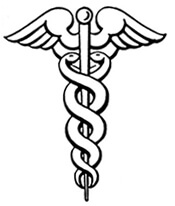
Color of the Crown Chakra
The dominating color of the crown chakra is white or gold. Reaching the crown chakra is largely equated with freedom from limitations and the boundaries of time and space. In this way, the crown is a link to the universal.
Liberation through the Crown Chakra
Those who have advanced practice in meditation may feel that the confines of their minds and bodies have been swept away and that they have merge with all that exists in the universe. Another way to look at this is that the blocks to recognizing that ongoing union have been dissolved.
Infographics for each chakra available
on our FREE STUFF page.
Sacred Geometry in Chakra Symbols
The shapes in chakra symbols originate with the five symbols of Yagna from the Vedic tradition. Yagna is a ritual involving offerings, prayers, and mantras. In addition, yagna often involves sacred fire.
Chakra Symbols and Yantras
Many of the shapes used in chakra symbols are also used in the creation of other forms of sacred art such as yantras. Yantras are symbolic representations of deities or aspects of God’s consciousness. Learn more in the article on Yantra Meaning. The meaning of the following shapes are consistent across these forms of sacred art.
Five Basic Forms in Chakra Symbols
The yagna five symbols are the square, circle, triangle, half-moon and ingots (also known as dumplings). The ingots are rectangular with a slightly larger base. This shape is associated with wealth, gold and silver.
Circle in Chakra Symbols
The circle symbolizes infinite space (the element akasha) and expansiveness. The circle also represents the cycles of nature at all levels from the atom to astronomy. The central quest of spirituality is to experience the Oneness of these realms.
Triangles in Chakra Symbols
The downward triangle is a depiction of the water element. An upward triangle represents the masculine energy and the element of fire. The triangle is the primary form that can enclose space within straight lines. This is the first form to emerge from chaos.
Related Video Shorts
Watch nearly 300 videos on our YouTube channel!
Square Meaning in Chakra Symbols
The square represents the four cardinal directions. A square symbolizes the foundation or base of the material world. The numeric equivalent of a square is four. The four sides may represent the four directions, the four winds or the Vedic element of earth.
Half-Moon in Chakra Symbols
The moon represents water energy and the emotions. The moon also symbolizes the unconscious mind and the hidden aspects of nature. The moon is generally a feminine symbol, often associated with goddesses.
Ingot or Dumpling in Chakra Symbols
The ingot of dumpling shape is connected to food, wealth, gold and abundance. This is a fortunate symbol originally connected to the offer of food or other valuable substances to fire in religious ceremonies.
Chakra Symbols and the Lotus
The lotus symbolizes purity, enlightenment and transcendence. Lotus petals are part of every chakra representation. Depending on the chakra, there may be anything from two to fifty petals or the proverbial “thousand-petalled lotus” of the crown chakra. In chakra art the lotus is usually viewed from the top, with the petals extending out on the rim of a circle.
Divine Meaning of the Lotus Flower
The lotus illustrates the unfolding of the divine essence within. The lotus is like the navel of creation. The lotus is sometimes depicted as springing from the navel of Vishnu and giving birth to Brahma, two of the gods in the Hindu trinity.
Lotus Meaning and the Heart
The lotus is also a symbol of the heart, especially the inner or secret chamber of the heart. This is sometimes called Brahma’s cave or the city of Brahma in the East or the inner castle in the West. This is the core of being that remains untouched by everyday living.
Lotus Petals and Sanskrit Sounds
The lotus petals depicted for a particular chakra correspond to sounds or letters of the Sanskrit alphabet. For example, the ten petals of the solar plexus chakra are associated with Sanskrit letters: dam, dham, nam, tam, tham, dam, dham, nam, pam, and pham. Each petal represents the overcoming of ten negative characteristics: ignorance, thirst, jealousy, treachery, shame, fear, disgust, delusion, foolishness and sadness.
More Chakra Resources
Chakras and Musical Notes: Chakras and musical notes have been paired in a number of ways. Learn about both Western and Eastern systems.
Chakra Names: Chakra names reveal the roles of the chakras in the body on psychological, spiritual and emotional levels. Includes explanations of English and Sanskrit chakra names.
Chakra Flowers: Chakra flowers offer unique symbolic meaning for each of the seven major chakras. Flowers are among the oldest spiritual symbols, revealing the meaning of each chakra.
Author Kathleen Karlsen
Kathleen Karlsen is a musician, artist, writer and speaker. She is the author of two books (Flower Symbols and Vocal Medicine) and over 200 articles. Kathleen, her husband Andrew, and their five children live in Bozeman, Montana. More about Kathleen Karlsen.
CHAKRA SYMBOLS ARTICLE SUMMARY
In the Hindu tradition, there are specific symbols for each of the seven major chakras. The organic and geometric forms in the chakra symbols depict the emotional, psychological and spiritual patterns associated with each chakra. Discover the meaning of these chakra symbols for a deeper understanding of the energetic system of the body.

